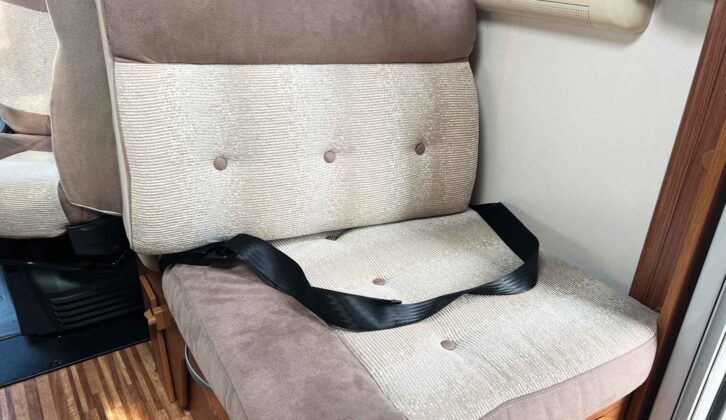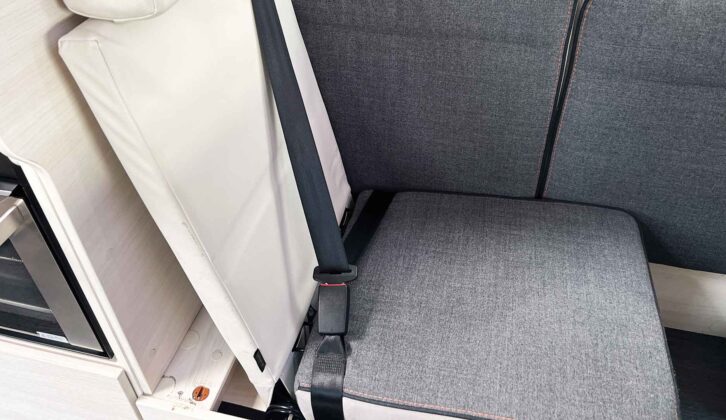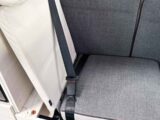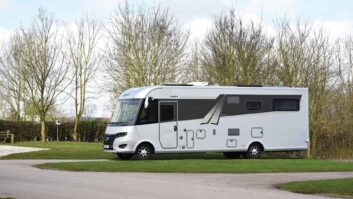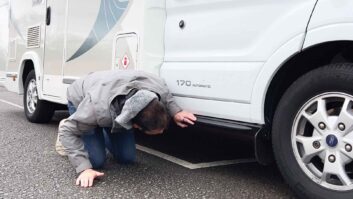Passenger seatbelts in a motorhome are a hot topic, often misunderstood. Common questions include “Can I carry passengers in the back of my ’van without seatbelts?” and “Can I install seatbelts in the rear?”.
The good news is I’m here to break down the facts, including the various laws you need to be aware of, the legal considerations, whether you can add seatbelts to your motorhome, and more.
Don’t miss my guide on motorhome upgrades either, where I share the 10 purchases that I think are well worth considering, or my tips on choosing between a new or used motorhome.
Motorhome seatbelt laws in the UK
The law on motorhome seatbelts varies, depending on when your vehicle was registered. Here are the facts:
- Post-2006 motorhomes: Forward-facing seats must have seatbelts fitted if your motorhome was registered after 2006. Passengers using those seats are legally required to wear them while travelling. This rule was introduced to improve safety and reduce the risk of injuries in accidents.
- Pre-2006 motorhomes: What about if you’re thinking of buying an older motorhome or already own one? Well, older motorhomes may have designated travel seats without seatbelts. Although it is not illegal for passengers to travel in these seats, it is strongly advised against, for safety reasons. Manufacturers were not required to install seatbelts in these vehicles, meaning that travelling unrestrained carries significant risk.
- Side-facing seats: The law does not require seatbelts on side-facing seats. However, using these seats while the vehicle is in motion is discouraged, owing to safety concerns due to the lack of protection. The gov.uk website says: “Although side facing seats, with or without seatbelts, are not illegal, we would not advise that they are used.”
- Children and seatbelts: If seatbelts are present, all passengers, especially children, must use them. Children aged under 12 years or shorter than 135cm must make use of an appropriate child restraint where seatbelts are available. This rule aligns with general road safety laws and is crucial for child protection.
A ‘travelling seat’ is one considered suitable for travel with a seatbelt by the manufacturer. It can be a forward- or rearward-facing seat.
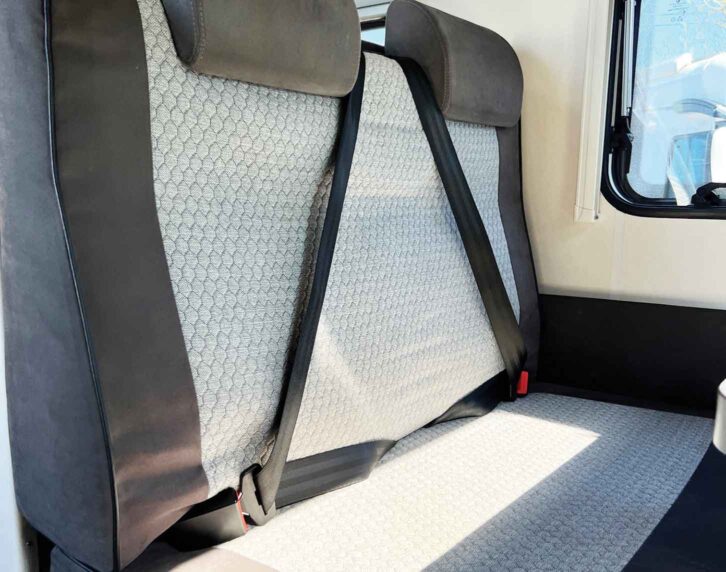
Forward-facing seats must have a three-point seatbelt. This is one that goes diagonally across your body. A rear-facing seat can be fitted with a lap belt. Although it might be legal for some passengers to travel without seatbelts, safety should always be the priority.
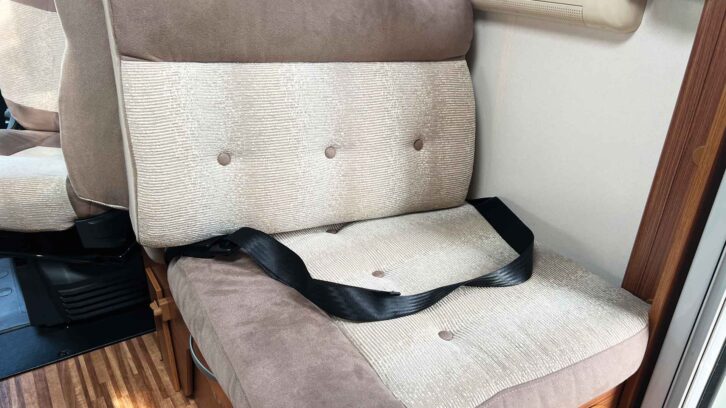
In an accident, unrestrained passengers can suffer serious injuries or cause harm to others inside the vehicle. A sudden stop or collision could result in a dangerous situation, where passengers are thrown forward.
Legal considerations
EU Directive 2005/40/EC was implemented on 20 October 2007. This legislation requires all newly manufactured vehicles, including motorhomes, to have seatbelts fitted for all designated travel seats. The directive introduced several key safety regulations:
- Designated travel seats: Motorhomes that were manufactured on or after 20 October 2007 must have seatbelts for all forward- and rearward-facing travel seats. These seats must be identified as such by the manufacturer.
- Side-facing seats: While not explicitly outlawed, side-facing seats are not recommended for travel, as they pose a higher risk of injury in a crash.
- MOT tests: During an MOT, seatbelt fittings are checked to ensure seatbelts are present where required and that belt mounting points and surrounding areas are not damaged or corroded.
- Older motorhomes: Vehicles registered before 20 October 2007 are not legally required to have seatbelts fitted in the rear.
- Seatbelts must be worn: Regardless of vehicle age, if a seatbelt has been fitted to a seat, it must be worn by the occupant while travelling.
In addition, under Regulation 100 of the Construction and Use Regulations and Section 40a of the Road Traffic Act 1988: Using Vehicles in a Dangerous Condition, police officers can take action if they believe the number of passengers or seating arrangements pose a danger to occupants or vehicle stability.
Can you add seatbelts to a motorhome?
If your motorhome doesn’t have enough seatbelts or you want to improve passenger safety, you might consider adding extra seatbelts. However, there are key factors to keep in mind:
- Structural integrity: Seatbelts must be anchored to reinforced sections of the motorhome. Adding them to furniture or wooden structures is unsafe.
- Check your payload: Your payload must be enough to carry an extra belted passenger (take a look at our guide to motorhome weights for more on this). Adding seats requires you to inform the DVLA, which might require your V5C to be updated.
- Insurance and compliance: Modifying your ’van by adding seatbelts might affect your insurance. Check with your insurer before making changes.
- Costs and practicality: Fitting seatbelts can require significant structural modifications. Consider whether it’s a practical and safe solution.
My advice
1. Only travel in designated travel seats. If a seat has no seatbelt, consider whether it’s safe to use.
2. Your V5C will confirm the number of approved travel seats. Carrying extra passengers could have legal and insurance implications.
3. If in doubt, ask a professional. Adding seatbelts isn’t always possible owing to structural limitations.
4. Even if the law allows it, ensure your passengers understand the risks of travelling with no seatbelt.
5. Avoid side-facing seats for travel. Although not illegal, they offer minimal crash protection.
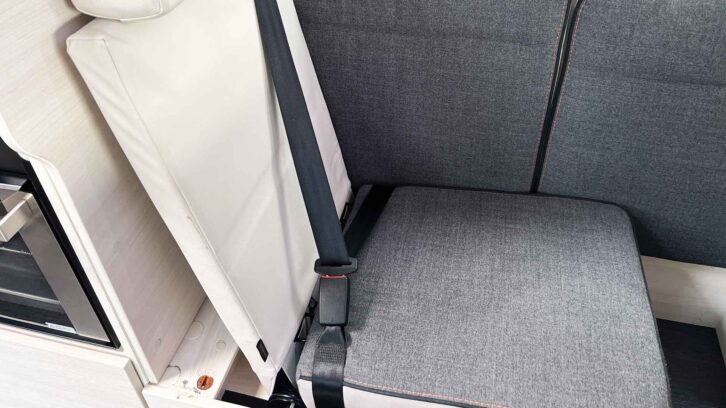
6. Consider upgrading your ’van. If seatbelt safety is a significant concern, buying a motorhome with properly installed seatbelts might be a better long-term solution.
Final thoughts
Although the law may permit some passengers to travel without a seatbelt in older ’vans, safety always comes first. If seatbelts are available, use them. If you’re considering modifications, ensure they’re done correctly and legally. Motorhoming should be fun, but it must also be safe.
You can find out more about me and listen to my podcast at motorhomematt.co.uk.
If you are considering upgrading your ‘van to get properly installed seatbelts, one thing you should look out for is a good motorhome warranty – it can be particularly important in these financially challenged times.
Future Publishing Limited, the publisher of Practical Motorhome, provides the information in this article in good faith and makes no representation as to its completeness or accuracy. Individuals carrying out the instructions do so at their own risk and must exercise their independent judgement in determining the appropriateness of the advice to their circumstances. To the fullest extent permitted by law, neither Future nor its employees or agents shall have any liability in connection with the use of this information. Double check any warranty is not affected before proceeding with any DIY alterations.
If you enjoyed reading this article, why not get the latest news, reviews and features delivered to your door or inbox every month? Take advantage of our brilliant Practical Motorhome SUBSCRIBERS’ OFFER and SIGN UP TO OUR NEWSLETTER for regular weekly updates on all things motorhome related.

